Okay, okay, okay…
I’m back.
Well, not that I ever “left” or anything, I’ve just been crazy extraordinarily busy with… stuff. You know, Stuff. (And no, this time it didn’t involve neither your grandma nor a bottle of rum).
But whatevs, time to get some serious ass-kicking blogging back on track!
HELL YEAH! *go Jesse!*
All right. Brushing my shoulders off. Straightening my blogging tie. Repositioning my pet-frog Mr. Miyagi. Sipping some fine o-cha (green tea).
Here we go:
Today’s article will be based around an e-mail I received about a month ago, but never answered (due to my recent mysterious busyness). It is an open and honest e-mail that I think resonates well with a lot of people, so hopefully you’ll learn a thing or two from my freakishly serious reply.
Look here (totally unedited, as always):
Dear most handsomest man in the Karate world,
Since you’ve interviewed a lot of karate champions (Lucio Maurino, Antonio Diaz, Patrick McCarthy…) on your #1 best super ultimate karate blog in the universe, I hope you can give me an answer to a small problem I have had for a long time. I’m a passionate karate practioner and have some problems with my shiko dachi (aka. sumo stance, horse stance etc.). Do you know (or where I can find) info about training and improving my shiko dachi (so it can look like a shiko dachi done by kata champions such as Antonio Diaz, etc…). Is a leg stretcher good equipment for this?
Hope to hear from you soon!
Regards
Sander
Wow.
Just…
Wow.
First of all… Leg-stretcher?
Really?
This seems more serious than I thought!
Second, (okay, sarcasm turned off), this is actually a very good topic. Why? Because Sander-san, my friend, you are not alone!
Having an ugly and/or weak (those two surprisingly often go hand in hand) shiko-dachi is a widespread phenomenon epidemic, seen all the way from Tokyo to Bangladesh to New York, resulting in a flood of repulsive katas and bleeding eyeballs of discerning judges, coaches and sensei around the world.

This must be stopped.
Right here, right now.
Sadly, most people think there is nothing to do about it. They blame their inadequate physical inabilities; their skeletal structure, their weak knees, or inflexible joints.
Well, newsflash, kiddo:
I don’t care.
(And neither do the care bears.)
Let’s just say that after having read this article, if you follow what I write to the point, you WILL have improved your shiko dachi – primarily its aesthetics, but hopefully its function(s) too. And that, my friend, is on my 110%-lifetime-money-back-KbJ-guarantee.
So, cutting the crap, here’s your plan of attack for getting an even awesomer shiko-dachi in no time with some training. All you need is a little basic info first, about the source of your shiko-dachi dilemma, and then I’ll hit you with five easy exercises to play with as much as you want to.
But first, understand the REAL source of your shiko-dachi problem:
In 99% of the cases with an unstable (or simply unpicturesque) shiko-dachi, the problem lies in your muscles. Not in your ligaments or tendons, not in your “I wasn’t born Chinese-gymnast-flexible”-mindset or “I don’t have money for a leg-stretcher machine”-attitude, but your muscles.
Specifically, the degree of tightness in your muscles.
See, when a muscle contracts, zillions of tiny ‘ratchets’, or cross-bridges, drag across each other. The more mini-ratchets that interact, the greater the tension the muscle generates. That’s great, and your muscles always display some tension; if they didn’t you would collapse in a Jabba the Hut like pile. So tension in itself is not the bad guy (as it is often portrayed), but rather dysfunctional tension is – tension in the wrong place at the wrong time or of the wrong intensity. Meaning, your muscles are contracted and shortened when they shouldn’t. Which, obviously, sucks.
So why do some people end up with these shortened muscles anyways?
Well, a so-called ‘tight muscle’ – which, believe me, is the #1 problem for most people’s shiko-dachi – has shortened for a variety of reasons; most often because of bad posture (hello computer!), injury, weakness, bad habits, incorrect (unbalanced) strength training or exhaustion. And sadly, a good shiko dachi (or a good anything really, including posture!) is incompatible with shortened muscles. Which sucks even more.
In fact, you could safely say that a tight muscle is nothing but a worthless lazy knot.
And who want’s one of those hanging around?
I don’t.
So let’s get rid of those.

How?
By doing some awesome exercises (note: not only “stretches”) that hit your shiko-dachi in numerous ways, from several angles, involving both quick and slow, painful and less painful sequences.
Let me teach you.
Read carefully:
#1: Sitting Lotus CRS Hip Stretch.
The first method we’re going to use is known as the CRS method. That stands for Contraction, Relaxation, Stretching, which pretty much sums up the idea behind this mind-blowingly effective method for increasing your passive flexibility in any part of your body (note: you need both active and passive flexibility to have a smashing shiko-dachi. We’ll get to the active part later).
Here’s what you do:
1. Sit with your feet together. This is a regular vanilla stretch seen in many dojos, but using the CRS method we will kick it up to another level, leaving the old method for grumpy dojo rats and textbook warriors.
2. Stretch like you’re used to, pushing gently down with your elbows, leaning forward a little (remember, always have your back straight when stretching). Do this for 5 seconds minimum.
3. Now, reversing the action, wedge your forearm between your legs and start to press your knees together like a maniac. Hold for 5 secs again.
4. Relax. Completely relax all of your muscles, letting your legs naturally stretch out without forcing anything. 5 secs is the protocol.
And that’s it.
Repeat this whole procedure three times and you’re done.
The secret of this exercise lies in fooling our own body that we’re in ‘danger’, since we’re in a stretched out (vulnerable) position resisting such a great force (our arm), which relaxes our muscles and joints instead (kicking in the golgi tendon organ), allowing us to subsequently stretch further than we previously could.
Slightly painful, yes.
But works wonders.
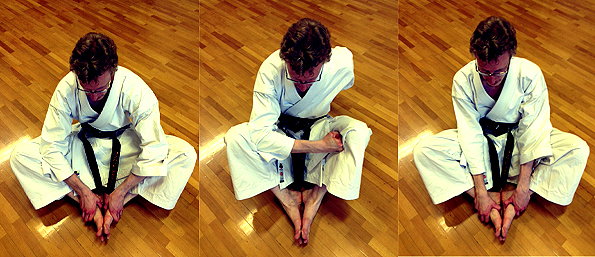
#2: Ukhtomsky’s Principle Belt Stretch.
For this one you’re definitely going to need a partner. Truthfully, the previous exercise works even better with a partner too, but can be done alone. This can’t.
So here’s what you do:
1. Stand in your best shiko dachi possible. Straight back, legs horizontal, knees above heels. Standard stuff.
2. Now have your partner lie behind you, attaching a belt to your belt, placing his/her feet on the back of your knees.
3. Both of you will now start pressing. You will press your knees out/back, while your partner will try to push your knees in/forward (but not too hard, it’s not a competition, stud!). Not more than 30 seconds, and never to exhaustion. Breathe shallow, don’t hold your breath.
4. Suddenly, without saying anything, your partner quickly removes his/her legs.
5. Bam, your knees “fall through” and push back more than you could ever have done by yourself.
Lather, rinse, repeat.
3-5 times is enough, relax between reps.
So how does this work? Well, as the title suggests, this exercise is based around Ukhtomsky’s principle. According to this neurological phenomenon, following the intense static contraction of a muscle, the muscle will keep on exerting itself for a period, while its antagonists will achieve an unusually deep relaxation. A more simple example is if you raise your knee as high as you can and then push it down with your hands. Remove the hands suddenly, and your knee will jump a couple of inches higher! Like with the previous exercise (#1), this principle can be applied to any stretch (hamstrings etc.).
A word on choosing your partner: Don’t just pick any bozo from the dojo/gym/street to be your stretching partner. If the two of you can’t communicate easily, you might get hurt. Beware of gender differences too; women are generally 20-25% more flexible than men – something to keep in mind before you snap somebody’s knee cap in your face just because you assumed they were as (in)flexible as you.
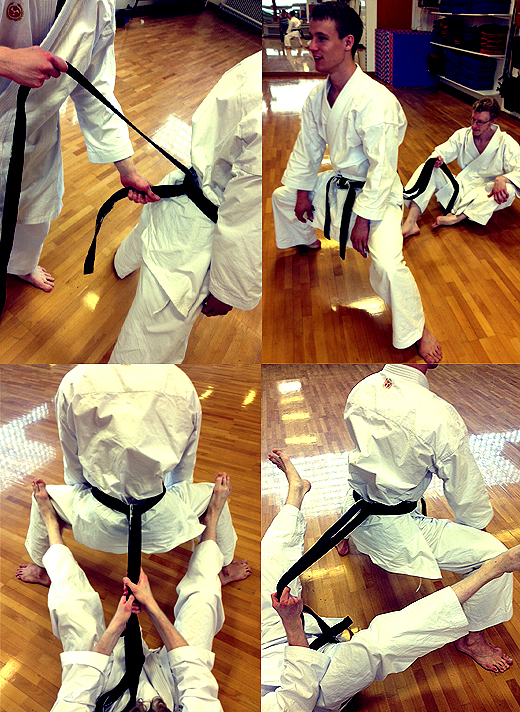
#3: The Shiko-Dachi Bench of Brutality
Oh man, I hate this exercise.
But it is soooo good. I can’t deny it.
I really can’t.
I’ll try to keep it short, because the shivers in my spine are getting worse for every word I write!
1. Get a bench. Make sure it’s black, like death and funerals.
2. Lie down, with your ass up, legs spread, like a pig about to get slaughtered (purely hypothetical, of course, I’ve actually never butchered a pig myself).
3. Pray.
4. Pop some potassium pills for the cramps you’re about to have.
5. Now bring your knees as high up as you can, towards the ceiling, keeping a 90 degree angle in hips and legs at all times, tensing your butt worse than a convict during his first welcome shower in prison.
6. Hold it. Hold it. Hold it. KEEP PRESSING UPWARDS!
7. Hold it some more.
8. Hold even MORE!
9. Fine, relax when you get the cramps.
This exercise doesn’t really have any significant external forces in play (except for gravity) like the two previous ones, but that’s not important right now. What’s important is that your muscles learn to tense, gradually forming a perfect shiko-dachi at the correct angle, by themselves. And, although stretching certainly is an integral part of the equation, this kind of strength training for your whole posterior chain is crucial for achieving a picture-perfect shiko-dachi.
Ever seen people who can easily do full splits, but can’t do a regular high kick slowly? That’s not because they lack the passive flexibility. They lack active flexibility – which is all about teaching your muscles to reach new lengths by themselves.
It won’t be easy, but it will definitely be worth it.
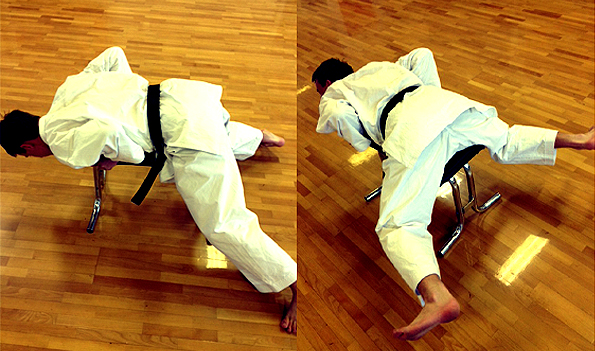
#4: Spiderman Shiko-Dachi Wall Hugs
This is more of a test, rather than a stretch or torture. The goal? To determine your current level of shiko-dachi-ness.
It’s very easy.
1. Stand in front of a wall, pretty close, in shiko dachi.
2. Gradually walk closer and closer. You’ll feel like a crab, but that’s okay. No one is looking.
3. Walk, walk, walk… until you’re either flat against the wall or fall over.
4. Remember how close you were and better luck next time.
To me, this is a super easy way to assess how flexible you are in your shiko dachi. Also, and perhaps more importantly (at least when it comes to the functionality of stances), it teaches you to have your balance centered – as you’ll notice if you are leaning forward (head touches the wall first) or leaning back (stomach/groin touches the wall first).
A fun exercise that doesn’t require much sweat or mess. Just a wall.
Everyone can do it.
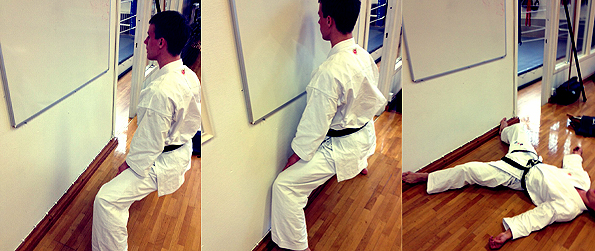
#5: The Leaning Tower of Shiko
Okay, last exercise. This is a fun, yet educational, one.
Edutainment at it’s finest, in other words.
1. Stand in your most awesome shiko-dachi. Make sure you have a mirror or sensei that can look at you – because you need to be stable like a sumo for this one.
2. Get a pal.
3. Now, as you stand still, trying to keep your balance, your partner will grab your shoulders and climb on top of you with both of his feet supported by your thighs. It is important that he/she doesn’t pull you in any direction too hard with his/her hands (or you’ll fall) during the climb.
4. Succeeded? Great!
5. BONUS: For additional fun, try climbing even higher, or do the 360-degree-climb-around.
As you’ll quickly notice, this exercise really tests the stability of your shiko-dachi, and even works with kids (it’s not quite as dangerous as it looks). Enjoy it!
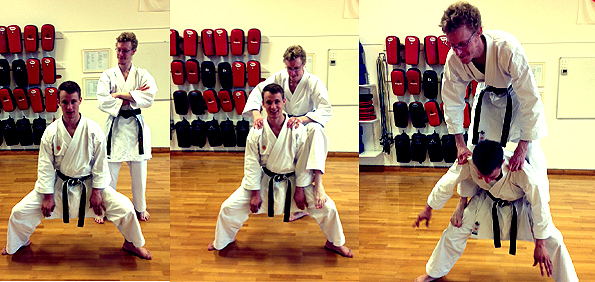
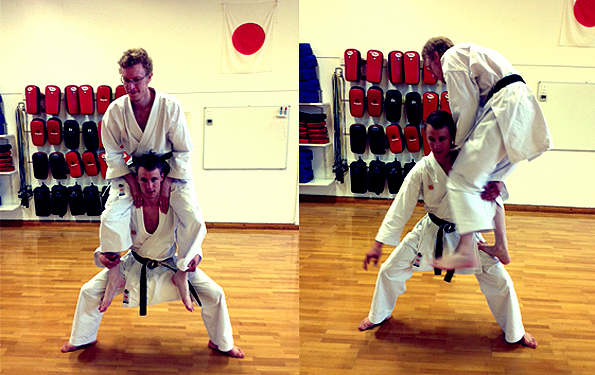
____
So, with that last crazy exercise, I believe today’s post on improving your shiko-dachi (jap. lit. ‘square stance‘) is officially over.
Hopefully, you learned a lesson or two.
The thing you must always have in mind is to actively work on the stance every time you use it. Because; if you don’t use it – you lose it. Simple as that.
Unfortunately, as some people seem to think, stances are not for resting in – they all have a specific purpose in the context of traditional Karate (whether combative or not) and should be given tons of more attention by most practitioners I see out there. At least that’s what my experience has taught me.
Because that’s when you really start to see changes happening.
In more areas than you probably realize.
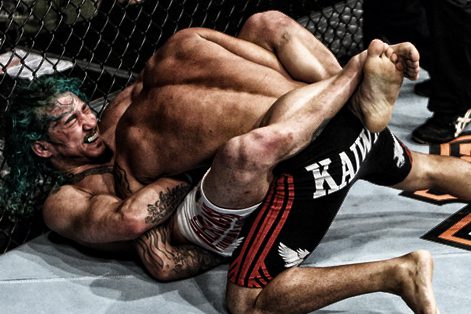


24 Comments